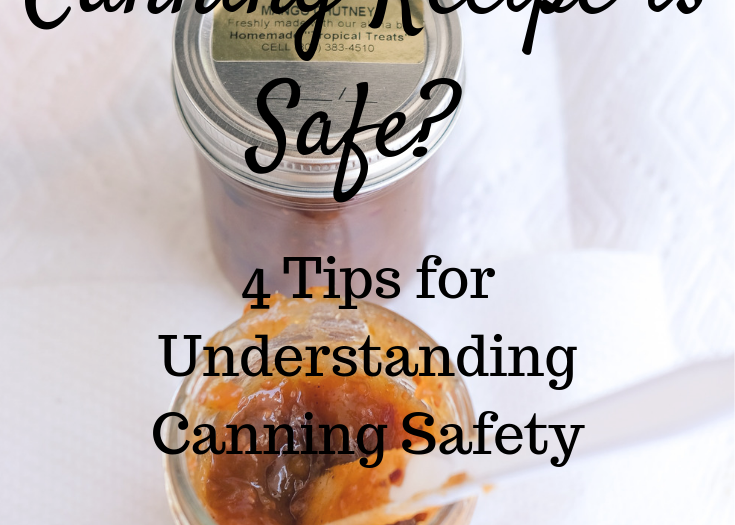“Aren’t you worried about poisoning yourself?”
Whenever I talk about canning with people who don’t do it, it never takes long before they ask this question.
I always say, “No, safe canning is easy, don’t be scared.”
But the fact is, I’m definitely concerned about poisoning myself and others. That’s why I follow safe practices. Improper canning procedure can result in ruined food, sickness, and in some extreme cases, death. (We all remember those green beans from East of Eden, right?)

So how do we know if a recipe is safe? It’s not hard, but you do need a little know-how.
1. Where is the recipe from?
The source matters. Canning recipes have more potential to be dangerous than regular recipes, so you’ll want to make sure the recipe source is trustworthy. You want recipes from people who understand canning and test their recipes for safety.
Great recipe sources include modern editions of The Ball Blue Book, Ball’s website, The National Center for Home Food Preservation, Healthy Canning, the directions inside your pectin box, and Food in Jars.
Sources that may not be trustworthy include: general recipe sites, Pinterest pins of unknown origin, the advice of your elderly relatives.
Only using trusted sources is the single safest way to choose a canning recipe. If you don’t know the source of the recipe, use extreme caution.
2. Understanding Acidity
The big danger with home canning is botulism. You will probably recover from other kinds of food poisoning, and mold, while a bummer, is easy to see. You can tell when spoiled food unseals a jar, starts to ferment or fizz, or otherwise makes itself known, botulism doesn’t do any of that. It’s undetectable and potentially deadly.
Botulinum spores grow and thrive and become toxins in moist low-acid, low-oxygen environments ranging from 40-120 degrees Fahrenheit. So inside an improperly canned jar of food is kind of botulism’s dream.
The only way to avoid it for sure is to follow the appropriate safe canning procedures. Botulinum spores have two enemies: acid and heat. You either have to create an appropriately acid environment, or heat things up really high.
There are basically three ways to safely can something at home: boiling water bath, steam canning, and pressure canning. Boiling water bath and steam canning are suitable for foods that are high in acid (with a time limit for steam canning). That’s basically fruit and pickles. The important thing is that the product to be canned has a ph of 4.6 or lower.
For low-acid foods, the only option is to use a pressure canner. Since there isn’t enough acid to inhibit botulism, you have to get the food hot enough to kill it, hotter than boiling. So for vegetables, meats, and low-acid combinations, a pressure canner is the only safe way.
Once you understand the issues with acid, it’s easier to tell if a recipe is safe. If a recipe calls for a high-acid method (water bathing) for a low-acid food, you automatically know it’s not safe. If a recipe compares well to a tested recipe (same ingredients, same volume, same proportion, same processing times), or only has high-acid ingredients, you’re probably good to go.
3. This Is Not The Time For Vintage
Look, you know I love a vintage recipe, but I don’t use them for canning. We’ve learned quite a bit about food safety in the past 120 years or so, and while vintage and antique recipes are very interesting to look at, they aren’t necessarily safe.
The current US guidelines for safe home canning are pretty stringent, and a lot of people ignore them in favor of what their grandmothers did. These include things like not processing jelly, canning in the oven, and not acidifying tomatoes. Not advisable, not any of it.
This is generally where people want to fight. “My grandmother did this for 50 years and no one got sick and it tastes better and Big Food just wants you to be scared and nobody in Europe uses boiling water baths and go screw yourself!” they yell.
I’m usually down for erring on the side of what your grandma would have done, but some things have changed. Some tomatoes aren’t as acidic as they used to be, for example. They are sweeter and more delicious, but now you have to acidify them to safely can them in boiling water by adding lemon juice or citric acid. Grandma didn’t have to, but we do.
Other old-time canning habits are just plain unsafe, and always have been. Boiling water does not get hotter than…boiling. Bacteria that can live at that temperature (*cough, botulism*) have always been able to live, and always had the potential to make people sick. Grandma was playing Russian Roulette when she boiling water processed the green beans, she just didn’t know it.
4. Use The Right Equipment
Again, no matter what Pinterest or your recipe tells you, don’t:
- can in something that isn’t a canning jar, like recycled mayonnaise jars (explosions! broken glass!)
- reuse canning lids (bad seal! ruined food!)
- can low-acid food in a boiling water bath (botulism! We talked about this!)
But Seriously, Safe Canning is Easy
Don’t be scared. If you follow best practices and think scientifically, it’s really not hard to can things safely. Grandma was right about one thing–home-canned food does taste better and it’s worth it to do it right.

